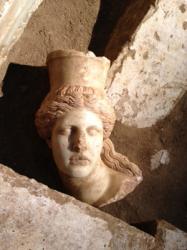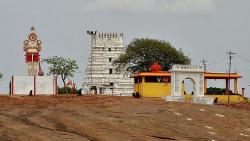INSTITUT SUPERIEUR D'ANTHROPOLOGIE
INSTITUTE OF ANTHROPOLOGY
ONLINE COURSES / COURS A DISTANCE
WINTER TERM : JANUARY 2015
REGISTER NOW
GRECE –  Amphipolis- Archaeologists digging at a tomb dating to the era of Alexander the Great in ancient Amphipolis in northern Greece have found the missing head of one of the two sphinxes guarding the entrance of the grave. According to a statement yesterday by the Culture Ministry, the head, which was found inside the tomb’s third chamber, belongs to the statue on the eastern side of the entrance. Barring some slight damage to the nose, the head is largely intact. The head measures 60 centimeters from top to bottom. Archaeologists also found fragments of that sphinx’s wings at the same chamber.
Amphipolis- Archaeologists digging at a tomb dating to the era of Alexander the Great in ancient Amphipolis in northern Greece have found the missing head of one of the two sphinxes guarding the entrance of the grave. According to a statement yesterday by the Culture Ministry, the head, which was found inside the tomb’s third chamber, belongs to the statue on the eastern side of the entrance. Barring some slight damage to the nose, the head is largely intact. The head measures 60 centimeters from top to bottom. Archaeologists also found fragments of that sphinx’s wings at the same chamber.
http://www.ekathimerini.com/4dcgi/_w_articles_wsite1_1_21/10/2014_543939?
GRECE - Piraeus - A Culture Ministry statement said Tuesday that the roughly half-meter (20-inch) high dressed male figure was found without its head, hands and feet, together with broken pottery dating to about 100-86 B.C. It was unclear who the statue might depict. The piece was found during an excavation of ancient wells in central Piraeus, where a new subway line will be built. Ancient wooden artefacts are uncommon discoveries in Greece as climate conditions do not favor their preservation. The ministry statement said the well also contained part of an ancient marble statue of a woman seated on a deer.
http://phys.org/news/2014-10-ancient-greek-yields-rare-wooden.html
INDE –  Keesaragutta - Twelve statues of Jain Tirthankara idols which could date back to as early as the 4th-5th century AD, have been found at Keesaragutta temple on the outskirts the Indian city of Hyderabad, Indian media reported on Tuesday. "Twelve panchaloha idols of the Jain Tirthankaras were unearthed during the course of conservation work 18, while the pathways were being laid between two temples near steps at a depth of one foot," the media quotes the director of Archaeology and Museums (Telangana), B Srinivas as telling reporters. Objects made from Panchaloha are composed of five metals of some sacred significance, and are often used for making Hindu temple idols."Twelve idols of varying sizes, along with loose circular prabharahs (auras), circular parasols of different sizes, pedestals and broken elephant have been found. All the bronzes (idols and other artifacts) are in the Kayotsarga posture (the so-called “dismissing the body” posture, when an idol is depicted standing stiffly) with a hook behind to accommodate chhatras (parasols) and 'prabhavali'," he explained. A Prabhavali is an aura around the deities, Srinivas added. Judging by the symbols on the chests and on the heads of the idols, the statues of the idols can be dated back to 4th-5th century AD, concluded the director of Archaeology and Museums. This is the first time “that the idols of Jain religion have been recovered in Keesaragutta, which proves that [the religion of] Jainism co-existed with Hinduism at Keesaragutta during the time of Vishnukundins in the 4-5th century," the official said, adding that chemical treatment would be conducted on the idols. Keesaragutta, also known as Kesaragiri, is a range of hills that are about 300 feet high (slightly above 90 meters) that rise from the planes; there are flat and undulating areas over the tops of the hills. The temple was enclosed by a fort wall which was constructed during the Vishnukundin period (an Indian dynasty that controlled parts of the country during the 5th and 6th centuries AD).
Keesaragutta - Twelve statues of Jain Tirthankara idols which could date back to as early as the 4th-5th century AD, have been found at Keesaragutta temple on the outskirts the Indian city of Hyderabad, Indian media reported on Tuesday. "Twelve panchaloha idols of the Jain Tirthankaras were unearthed during the course of conservation work 18, while the pathways were being laid between two temples near steps at a depth of one foot," the media quotes the director of Archaeology and Museums (Telangana), B Srinivas as telling reporters. Objects made from Panchaloha are composed of five metals of some sacred significance, and are often used for making Hindu temple idols."Twelve idols of varying sizes, along with loose circular prabharahs (auras), circular parasols of different sizes, pedestals and broken elephant have been found. All the bronzes (idols and other artifacts) are in the Kayotsarga posture (the so-called “dismissing the body” posture, when an idol is depicted standing stiffly) with a hook behind to accommodate chhatras (parasols) and 'prabhavali'," he explained. A Prabhavali is an aura around the deities, Srinivas added. Judging by the symbols on the chests and on the heads of the idols, the statues of the idols can be dated back to 4th-5th century AD, concluded the director of Archaeology and Museums. This is the first time “that the idols of Jain religion have been recovered in Keesaragutta, which proves that [the religion of] Jainism co-existed with Hinduism at Keesaragutta during the time of Vishnukundins in the 4-5th century," the official said, adding that chemical treatment would be conducted on the idols. Keesaragutta, also known as Kesaragiri, is a range of hills that are about 300 feet high (slightly above 90 meters) that rise from the planes; there are flat and undulating areas over the tops of the hills. The temple was enclosed by a fort wall which was constructed during the Vishnukundin period (an Indian dynasty that controlled parts of the country during the 5th and 6th centuries AD).
http://en.ria.ru/society/20141021/194384072/Twelve-Ancient-Statues-of-Jain-Tirthankara-Deities-Found-in.html?
BULGARIE –  Dobrich - Archaeologists excavating a fortress near Bulgaria's north eastern town of Dobrich unearthed bronze elements from a belt of a Bulgar warrior, reports the Standart daily. Archaeologist Boyan Totev told journalists that this is the first such find by archaeologists in Bulgaria. Parts of another belt has been found by treasure hunters, again near Dobrich. “This one is whole and we expect to find the buckle and the loop,” he said. “The elements are made of bronze and are dated end of IX c. AD. The belt belonged to a middle rank soldier and has been decorated with floral motives.” The director of the Dobrich regional history museum Kostadin Kostadinov told the journalists that the fortress was probably built to guard the basilica which was already found nearby. The entire area is a cult site and archaeologists suspect that further excavations can find more religious artifacts and buildings. Earlier this year at the same site the archaeologists excavated a church treasure of bronze Byzantine coins.
Dobrich - Archaeologists excavating a fortress near Bulgaria's north eastern town of Dobrich unearthed bronze elements from a belt of a Bulgar warrior, reports the Standart daily. Archaeologist Boyan Totev told journalists that this is the first such find by archaeologists in Bulgaria. Parts of another belt has been found by treasure hunters, again near Dobrich. “This one is whole and we expect to find the buckle and the loop,” he said. “The elements are made of bronze and are dated end of IX c. AD. The belt belonged to a middle rank soldier and has been decorated with floral motives.” The director of the Dobrich regional history museum Kostadin Kostadinov told the journalists that the fortress was probably built to guard the basilica which was already found nearby. The entire area is a cult site and archaeologists suspect that further excavations can find more religious artifacts and buildings. Earlier this year at the same site the archaeologists excavated a church treasure of bronze Byzantine coins.
http://www.novinite.com/articles/164228/Archaeologists+Unearth+Bronze+Belt+Of+Bulgar+Warrior?
ROYAUME UNI –  Larkhill Camp - Digging War Horse is part of the First World War centenary celebrations and aims to discover how and where the huge number of horses and mules that hauled weaponry, stores and personnel to and from the front line were cared for. The latest phase involved the excavation of a site at Larkhill Camp on Salisbury Plain. Documentary evidence suggested this to be the site of a specialised veterinary hospital which would have quarantined and cared for some of the 500,000 animals commandeered from British families or imported from the Americas and Iberian Peninsula during the Great War. Test pits were dug and a controlled metal detection survey of the site was conducted. No physical trace of the horse hospital buildings survived, however, horse shoes, farrier’s nails and various materials associated with equine activity were found.
Larkhill Camp - Digging War Horse is part of the First World War centenary celebrations and aims to discover how and where the huge number of horses and mules that hauled weaponry, stores and personnel to and from the front line were cared for. The latest phase involved the excavation of a site at Larkhill Camp on Salisbury Plain. Documentary evidence suggested this to be the site of a specialised veterinary hospital which would have quarantined and cared for some of the 500,000 animals commandeered from British families or imported from the Americas and Iberian Peninsula during the Great War. Test pits were dug and a controlled metal detection survey of the site was conducted. No physical trace of the horse hospital buildings survived, however, horse shoes, farrier’s nails and various materials associated with equine activity were found.
http://www.bristol.ac.uk/news/2014/october/digging-war-horse.html